Leadership & Management in Service Industries: Unit 5 Report Analysis
VerifiedAdded on 2023/01/12
|12
|3925
|96
Report
AI Summary
This report delves into the critical aspects of leadership and management within the service industries, using CT Business Travel as a case study. It begins with an introduction highlighting the significance of effective leadership and management in enhancing organizational productivity. The report is divided into two parts: Part A examines classical management theories like scientific and bureaucratic management, detailing their strengths and weaknesses, alongside the roles of leaders and different leadership styles such as democratic, autocratic, and laissez-faire. It also discusses various management styles including persuasive, participative, and result-based management, and utilizes SWOT and PEST analyses to evaluate the company's internal and external environments. Part B focuses on the essential hard and soft skills required in the service industry and identifies future skills that will be important for success. The report concludes with a comparison of CT Business Travel and Cost Saver, summarizing key findings and providing references.
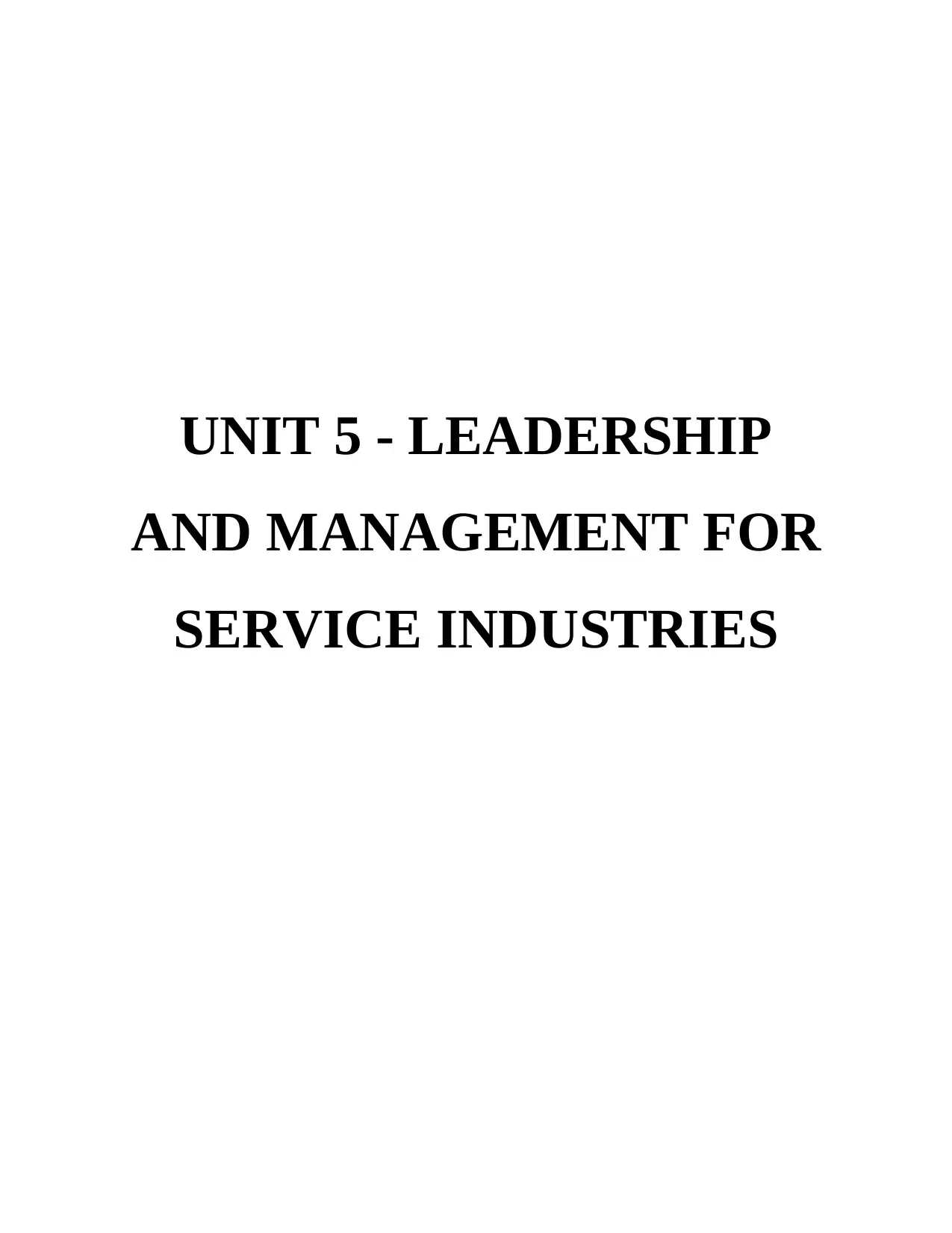
UNIT 5 - LEADERSHIP
AND MANAGEMENT FOR
SERVICE INDUSTRIES
AND MANAGEMENT FOR
SERVICE INDUSTRIES
Paraphrase This Document
Need a fresh take? Get an instant paraphrase of this document with our AI Paraphraser
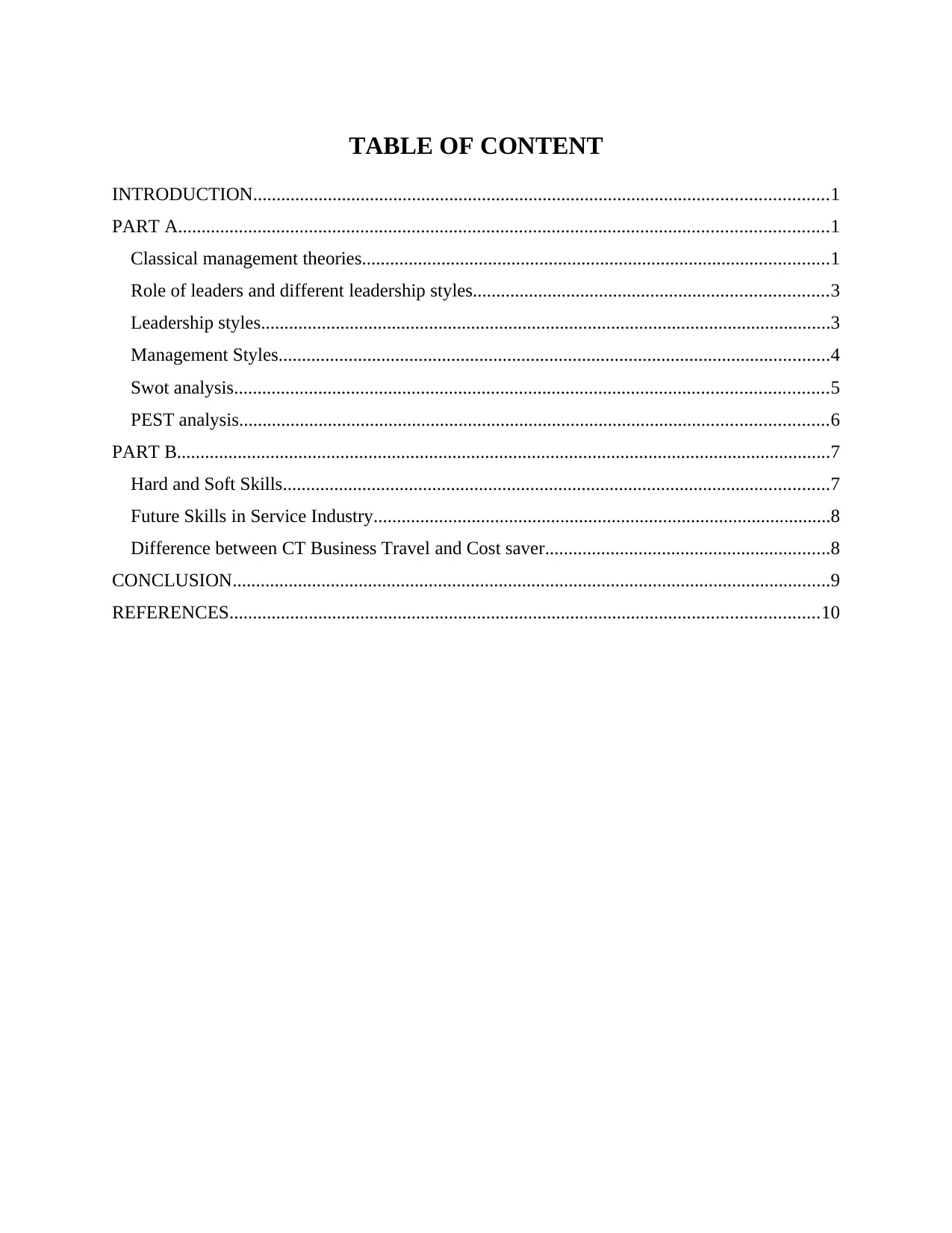
TABLE OF CONTENT
INTRODUCTION...........................................................................................................................1
PART A...........................................................................................................................................1
Classical management theories....................................................................................................1
Role of leaders and different leadership styles............................................................................3
Leadership styles..........................................................................................................................3
Management Styles......................................................................................................................4
Swot analysis...............................................................................................................................5
PEST analysis..............................................................................................................................6
PART B............................................................................................................................................7
Hard and Soft Skills.....................................................................................................................7
Future Skills in Service Industry..................................................................................................8
Difference between CT Business Travel and Cost saver.............................................................8
CONCLUSION................................................................................................................................9
REFERENCES..............................................................................................................................10
INTRODUCTION...........................................................................................................................1
PART A...........................................................................................................................................1
Classical management theories....................................................................................................1
Role of leaders and different leadership styles............................................................................3
Leadership styles..........................................................................................................................3
Management Styles......................................................................................................................4
Swot analysis...............................................................................................................................5
PEST analysis..............................................................................................................................6
PART B............................................................................................................................................7
Hard and Soft Skills.....................................................................................................................7
Future Skills in Service Industry..................................................................................................8
Difference between CT Business Travel and Cost saver.............................................................8
CONCLUSION................................................................................................................................9
REFERENCES..............................................................................................................................10
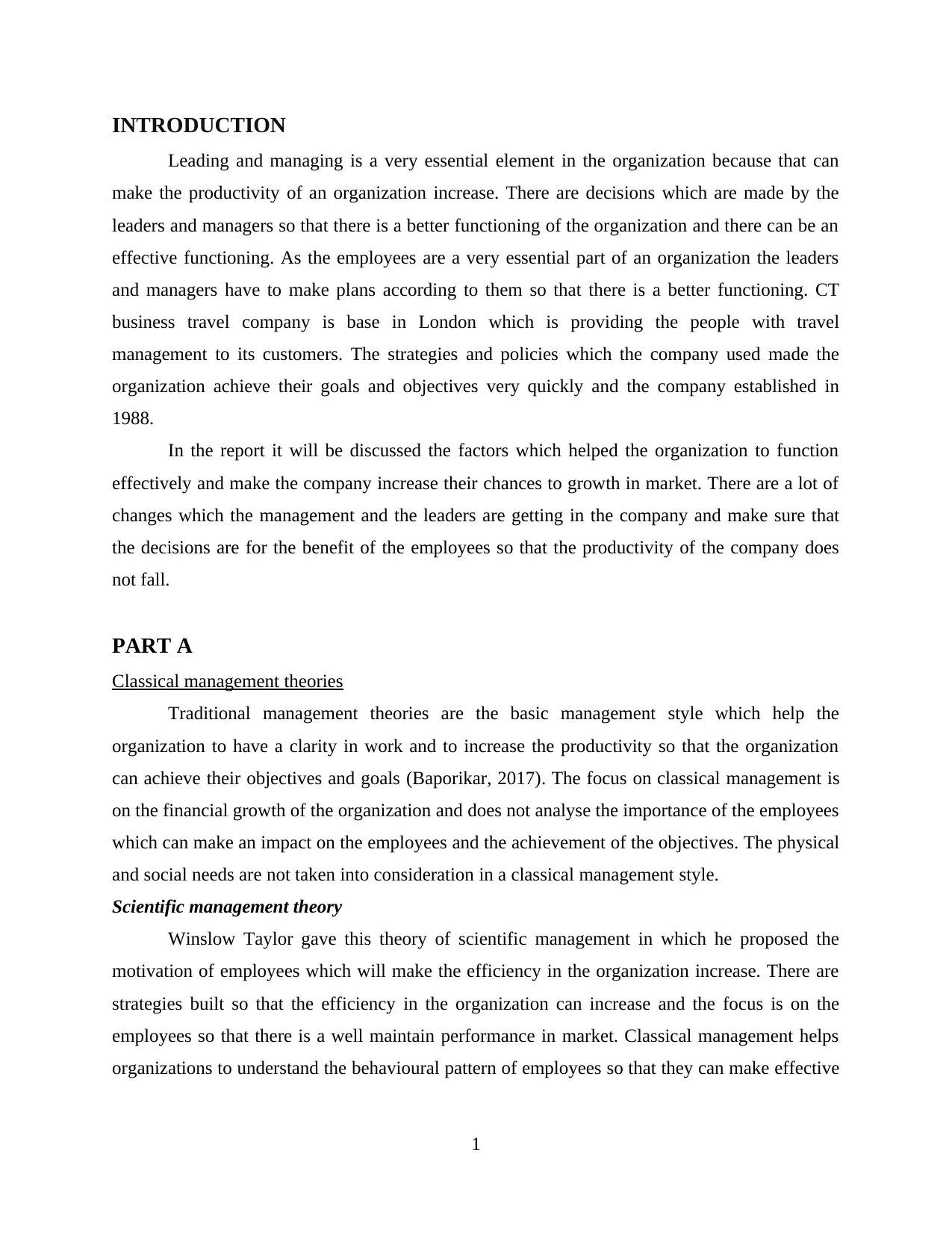
INTRODUCTION
Leading and managing is a very essential element in the organization because that can
make the productivity of an organization increase. There are decisions which are made by the
leaders and managers so that there is a better functioning of the organization and there can be an
effective functioning. As the employees are a very essential part of an organization the leaders
and managers have to make plans according to them so that there is a better functioning. CT
business travel company is base in London which is providing the people with travel
management to its customers. The strategies and policies which the company used made the
organization achieve their goals and objectives very quickly and the company established in
1988.
In the report it will be discussed the factors which helped the organization to function
effectively and make the company increase their chances to growth in market. There are a lot of
changes which the management and the leaders are getting in the company and make sure that
the decisions are for the benefit of the employees so that the productivity of the company does
not fall.
PART A
Classical management theories
Traditional management theories are the basic management style which help the
organization to have a clarity in work and to increase the productivity so that the organization
can achieve their objectives and goals (Baporikar, 2017). The focus on classical management is
on the financial growth of the organization and does not analyse the importance of the employees
which can make an impact on the employees and the achievement of the objectives. The physical
and social needs are not taken into consideration in a classical management style.
Scientific management theory
Winslow Taylor gave this theory of scientific management in which he proposed the
motivation of employees which will make the efficiency in the organization increase. There are
strategies built so that the efficiency in the organization can increase and the focus is on the
employees so that there is a well maintain performance in market. Classical management helps
organizations to understand the behavioural pattern of employees so that they can make effective
1
Leading and managing is a very essential element in the organization because that can
make the productivity of an organization increase. There are decisions which are made by the
leaders and managers so that there is a better functioning of the organization and there can be an
effective functioning. As the employees are a very essential part of an organization the leaders
and managers have to make plans according to them so that there is a better functioning. CT
business travel company is base in London which is providing the people with travel
management to its customers. The strategies and policies which the company used made the
organization achieve their goals and objectives very quickly and the company established in
1988.
In the report it will be discussed the factors which helped the organization to function
effectively and make the company increase their chances to growth in market. There are a lot of
changes which the management and the leaders are getting in the company and make sure that
the decisions are for the benefit of the employees so that the productivity of the company does
not fall.
PART A
Classical management theories
Traditional management theories are the basic management style which help the
organization to have a clarity in work and to increase the productivity so that the organization
can achieve their objectives and goals (Baporikar, 2017). The focus on classical management is
on the financial growth of the organization and does not analyse the importance of the employees
which can make an impact on the employees and the achievement of the objectives. The physical
and social needs are not taken into consideration in a classical management style.
Scientific management theory
Winslow Taylor gave this theory of scientific management in which he proposed the
motivation of employees which will make the efficiency in the organization increase. There are
strategies built so that the efficiency in the organization can increase and the focus is on the
employees so that there is a well maintain performance in market. Classical management helps
organizations to understand the behavioural pattern of employees so that they can make effective
1
⊘ This is a preview!⊘
Do you want full access?
Subscribe today to unlock all pages.

Trusted by 1+ million students worldwide
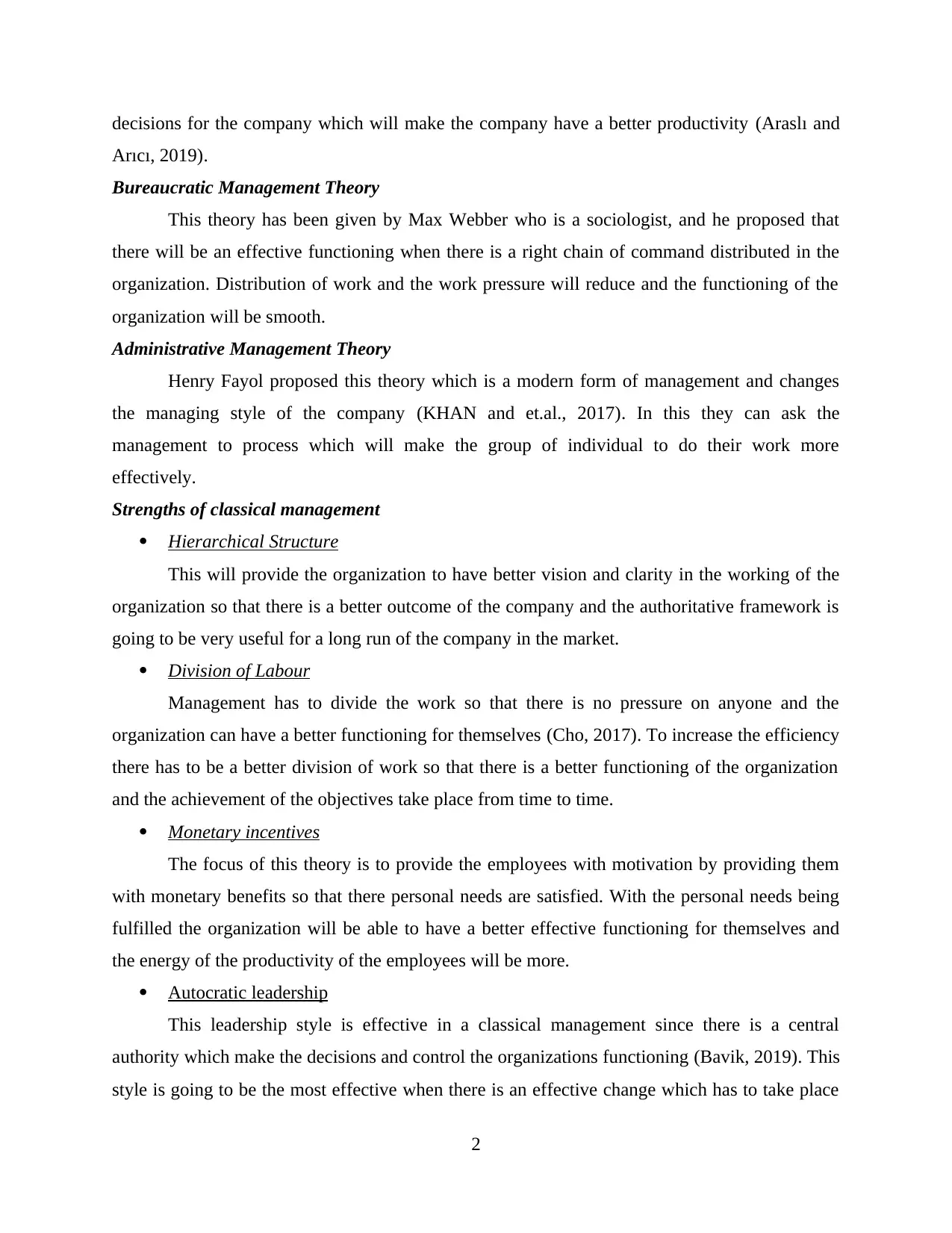
decisions for the company which will make the company have a better productivity (Araslı and
Arıcı, 2019).
Bureaucratic Management Theory
This theory has been given by Max Webber who is a sociologist, and he proposed that
there will be an effective functioning when there is a right chain of command distributed in the
organization. Distribution of work and the work pressure will reduce and the functioning of the
organization will be smooth.
Administrative Management Theory
Henry Fayol proposed this theory which is a modern form of management and changes
the managing style of the company (KHAN and et.al., 2017). In this they can ask the
management to process which will make the group of individual to do their work more
effectively.
Strengths of classical management
Hierarchical Structure
This will provide the organization to have better vision and clarity in the working of the
organization so that there is a better outcome of the company and the authoritative framework is
going to be very useful for a long run of the company in the market.
Division of Labour
Management has to divide the work so that there is no pressure on anyone and the
organization can have a better functioning for themselves (Cho, 2017). To increase the efficiency
there has to be a better division of work so that there is a better functioning of the organization
and the achievement of the objectives take place from time to time.
Monetary incentives
The focus of this theory is to provide the employees with motivation by providing them
with monetary benefits so that there personal needs are satisfied. With the personal needs being
fulfilled the organization will be able to have a better effective functioning for themselves and
the energy of the productivity of the employees will be more.
Autocratic leadership
This leadership style is effective in a classical management since there is a central
authority which make the decisions and control the organizations functioning (Bavik, 2019). This
style is going to be the most effective when there is an effective change which has to take place
2
Arıcı, 2019).
Bureaucratic Management Theory
This theory has been given by Max Webber who is a sociologist, and he proposed that
there will be an effective functioning when there is a right chain of command distributed in the
organization. Distribution of work and the work pressure will reduce and the functioning of the
organization will be smooth.
Administrative Management Theory
Henry Fayol proposed this theory which is a modern form of management and changes
the managing style of the company (KHAN and et.al., 2017). In this they can ask the
management to process which will make the group of individual to do their work more
effectively.
Strengths of classical management
Hierarchical Structure
This will provide the organization to have better vision and clarity in the working of the
organization so that there is a better outcome of the company and the authoritative framework is
going to be very useful for a long run of the company in the market.
Division of Labour
Management has to divide the work so that there is no pressure on anyone and the
organization can have a better functioning for themselves (Cho, 2017). To increase the efficiency
there has to be a better division of work so that there is a better functioning of the organization
and the achievement of the objectives take place from time to time.
Monetary incentives
The focus of this theory is to provide the employees with motivation by providing them
with monetary benefits so that there personal needs are satisfied. With the personal needs being
fulfilled the organization will be able to have a better effective functioning for themselves and
the energy of the productivity of the employees will be more.
Autocratic leadership
This leadership style is effective in a classical management since there is a central
authority which make the decisions and control the organizations functioning (Bavik, 2019). This
style is going to be the most effective when there is an effective change which has to take place
2
Paraphrase This Document
Need a fresh take? Get an instant paraphrase of this document with our AI Paraphraser
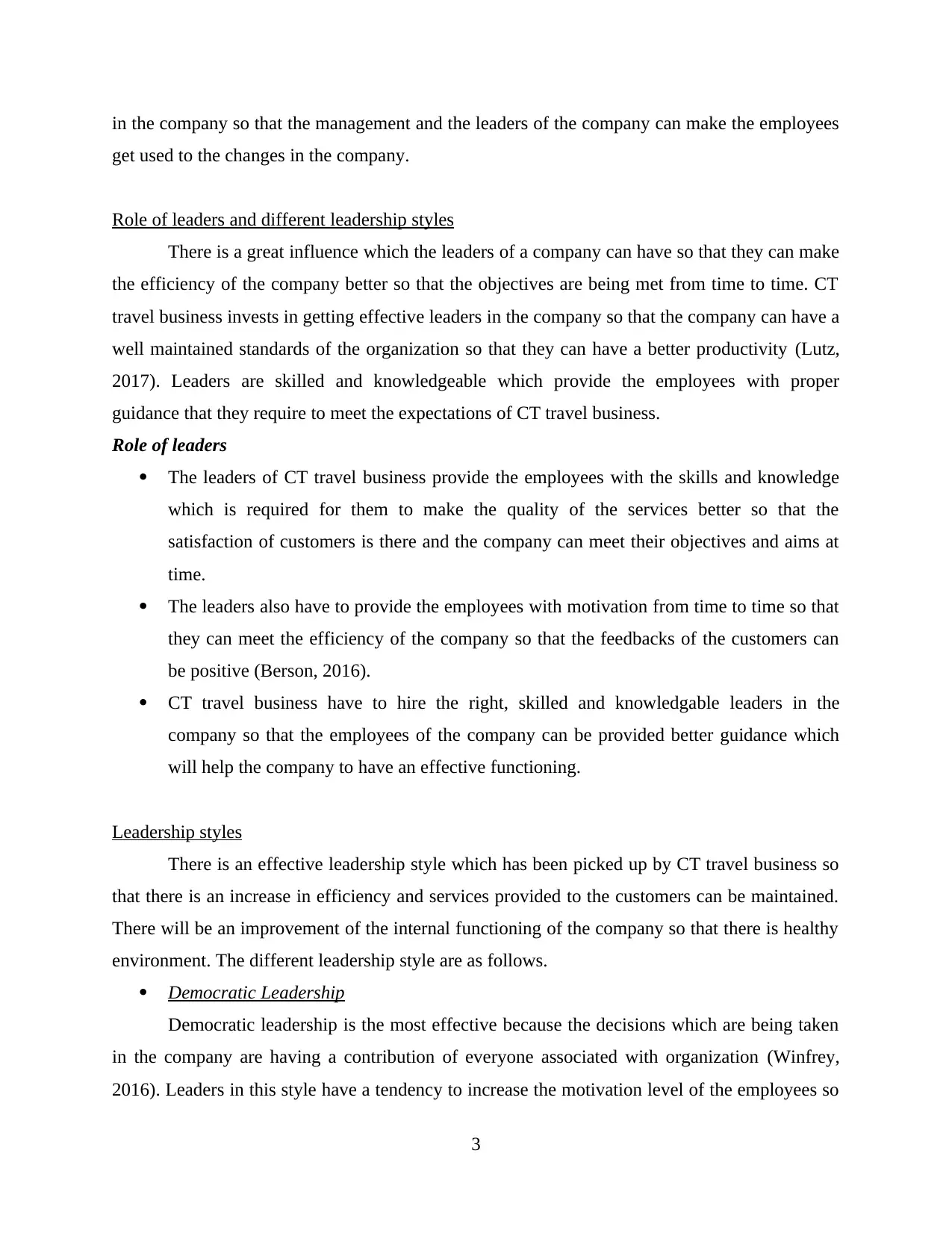
in the company so that the management and the leaders of the company can make the employees
get used to the changes in the company.
Role of leaders and different leadership styles
There is a great influence which the leaders of a company can have so that they can make
the efficiency of the company better so that the objectives are being met from time to time. CT
travel business invests in getting effective leaders in the company so that the company can have a
well maintained standards of the organization so that they can have a better productivity (Lutz,
2017). Leaders are skilled and knowledgeable which provide the employees with proper
guidance that they require to meet the expectations of CT travel business.
Role of leaders
The leaders of CT travel business provide the employees with the skills and knowledge
which is required for them to make the quality of the services better so that the
satisfaction of customers is there and the company can meet their objectives and aims at
time.
The leaders also have to provide the employees with motivation from time to time so that
they can meet the efficiency of the company so that the feedbacks of the customers can
be positive (Berson, 2016).
CT travel business have to hire the right, skilled and knowledgable leaders in the
company so that the employees of the company can be provided better guidance which
will help the company to have an effective functioning.
Leadership styles
There is an effective leadership style which has been picked up by CT travel business so
that there is an increase in efficiency and services provided to the customers can be maintained.
There will be an improvement of the internal functioning of the company so that there is healthy
environment. The different leadership style are as follows.
Democratic Leadership
Democratic leadership is the most effective because the decisions which are being taken
in the company are having a contribution of everyone associated with organization (Winfrey,
2016). Leaders in this style have a tendency to increase the motivation level of the employees so
3
get used to the changes in the company.
Role of leaders and different leadership styles
There is a great influence which the leaders of a company can have so that they can make
the efficiency of the company better so that the objectives are being met from time to time. CT
travel business invests in getting effective leaders in the company so that the company can have a
well maintained standards of the organization so that they can have a better productivity (Lutz,
2017). Leaders are skilled and knowledgeable which provide the employees with proper
guidance that they require to meet the expectations of CT travel business.
Role of leaders
The leaders of CT travel business provide the employees with the skills and knowledge
which is required for them to make the quality of the services better so that the
satisfaction of customers is there and the company can meet their objectives and aims at
time.
The leaders also have to provide the employees with motivation from time to time so that
they can meet the efficiency of the company so that the feedbacks of the customers can
be positive (Berson, 2016).
CT travel business have to hire the right, skilled and knowledgable leaders in the
company so that the employees of the company can be provided better guidance which
will help the company to have an effective functioning.
Leadership styles
There is an effective leadership style which has been picked up by CT travel business so
that there is an increase in efficiency and services provided to the customers can be maintained.
There will be an improvement of the internal functioning of the company so that there is healthy
environment. The different leadership style are as follows.
Democratic Leadership
Democratic leadership is the most effective because the decisions which are being taken
in the company are having a contribution of everyone associated with organization (Winfrey,
2016). Leaders in this style have a tendency to increase the motivation level of the employees so
3
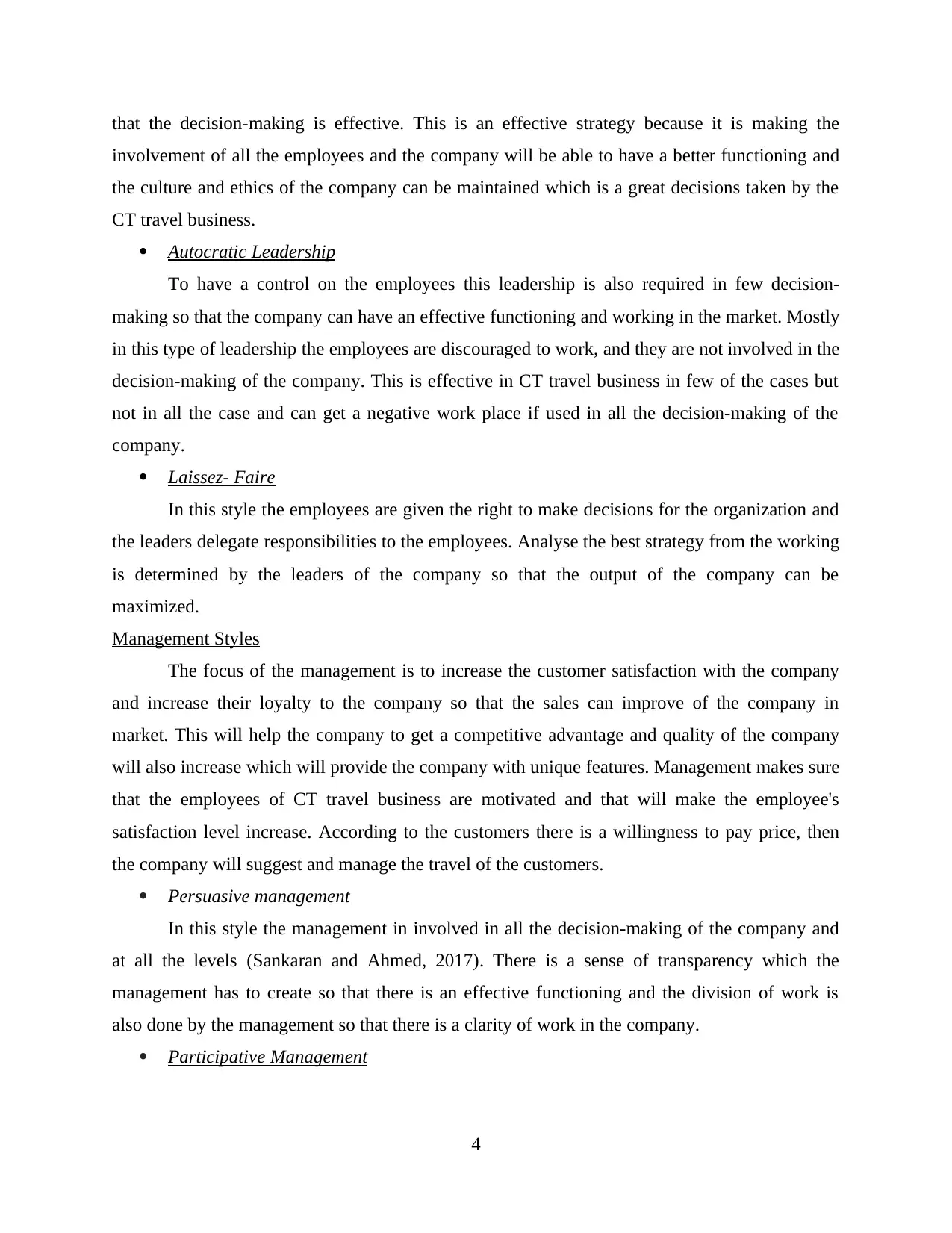
that the decision-making is effective. This is an effective strategy because it is making the
involvement of all the employees and the company will be able to have a better functioning and
the culture and ethics of the company can be maintained which is a great decisions taken by the
CT travel business.
Autocratic Leadership
To have a control on the employees this leadership is also required in few decision-
making so that the company can have an effective functioning and working in the market. Mostly
in this type of leadership the employees are discouraged to work, and they are not involved in the
decision-making of the company. This is effective in CT travel business in few of the cases but
not in all the case and can get a negative work place if used in all the decision-making of the
company.
Laissez- Faire
In this style the employees are given the right to make decisions for the organization and
the leaders delegate responsibilities to the employees. Analyse the best strategy from the working
is determined by the leaders of the company so that the output of the company can be
maximized.
Management Styles
The focus of the management is to increase the customer satisfaction with the company
and increase their loyalty to the company so that the sales can improve of the company in
market. This will help the company to get a competitive advantage and quality of the company
will also increase which will provide the company with unique features. Management makes sure
that the employees of CT travel business are motivated and that will make the employee's
satisfaction level increase. According to the customers there is a willingness to pay price, then
the company will suggest and manage the travel of the customers.
Persuasive management
In this style the management in involved in all the decision-making of the company and
at all the levels (Sankaran and Ahmed, 2017). There is a sense of transparency which the
management has to create so that there is an effective functioning and the division of work is
also done by the management so that there is a clarity of work in the company.
Participative Management
4
involvement of all the employees and the company will be able to have a better functioning and
the culture and ethics of the company can be maintained which is a great decisions taken by the
CT travel business.
Autocratic Leadership
To have a control on the employees this leadership is also required in few decision-
making so that the company can have an effective functioning and working in the market. Mostly
in this type of leadership the employees are discouraged to work, and they are not involved in the
decision-making of the company. This is effective in CT travel business in few of the cases but
not in all the case and can get a negative work place if used in all the decision-making of the
company.
Laissez- Faire
In this style the employees are given the right to make decisions for the organization and
the leaders delegate responsibilities to the employees. Analyse the best strategy from the working
is determined by the leaders of the company so that the output of the company can be
maximized.
Management Styles
The focus of the management is to increase the customer satisfaction with the company
and increase their loyalty to the company so that the sales can improve of the company in
market. This will help the company to get a competitive advantage and quality of the company
will also increase which will provide the company with unique features. Management makes sure
that the employees of CT travel business are motivated and that will make the employee's
satisfaction level increase. According to the customers there is a willingness to pay price, then
the company will suggest and manage the travel of the customers.
Persuasive management
In this style the management in involved in all the decision-making of the company and
at all the levels (Sankaran and Ahmed, 2017). There is a sense of transparency which the
management has to create so that there is an effective functioning and the division of work is
also done by the management so that there is a clarity of work in the company.
Participative Management
4
⊘ This is a preview!⊘
Do you want full access?
Subscribe today to unlock all pages.

Trusted by 1+ million students worldwide
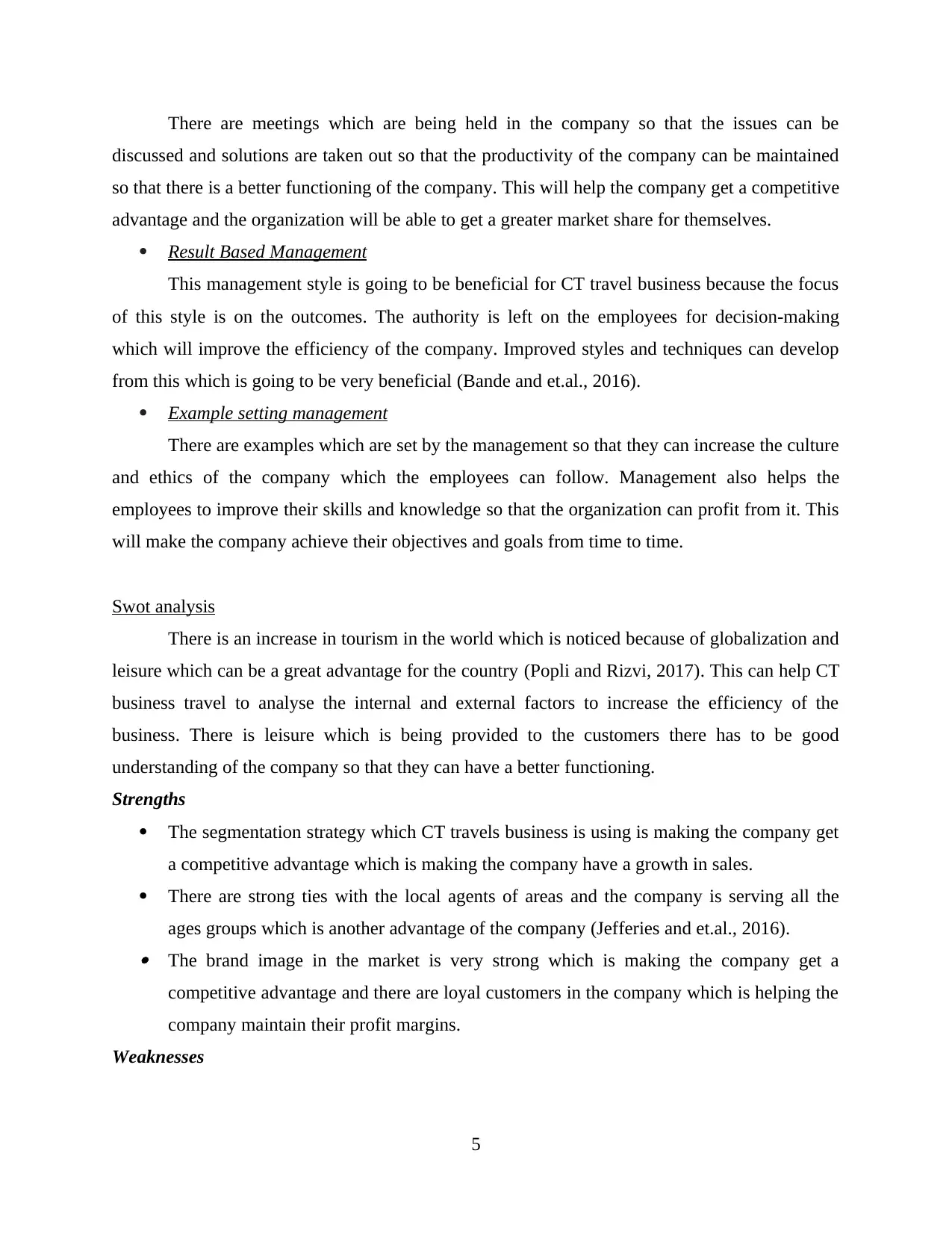
There are meetings which are being held in the company so that the issues can be
discussed and solutions are taken out so that the productivity of the company can be maintained
so that there is a better functioning of the company. This will help the company get a competitive
advantage and the organization will be able to get a greater market share for themselves.
Result Based Management
This management style is going to be beneficial for CT travel business because the focus
of this style is on the outcomes. The authority is left on the employees for decision-making
which will improve the efficiency of the company. Improved styles and techniques can develop
from this which is going to be very beneficial (Bande and et.al., 2016).
Example setting management
There are examples which are set by the management so that they can increase the culture
and ethics of the company which the employees can follow. Management also helps the
employees to improve their skills and knowledge so that the organization can profit from it. This
will make the company achieve their objectives and goals from time to time.
Swot analysis
There is an increase in tourism in the world which is noticed because of globalization and
leisure which can be a great advantage for the country (Popli and Rizvi, 2017). This can help CT
business travel to analyse the internal and external factors to increase the efficiency of the
business. There is leisure which is being provided to the customers there has to be good
understanding of the company so that they can have a better functioning.
Strengths
The segmentation strategy which CT travels business is using is making the company get
a competitive advantage which is making the company have a growth in sales.
There are strong ties with the local agents of areas and the company is serving all the
ages groups which is another advantage of the company (Jefferies and et.al., 2016). The brand image in the market is very strong which is making the company get a
competitive advantage and there are loyal customers in the company which is helping the
company maintain their profit margins.
Weaknesses
5
discussed and solutions are taken out so that the productivity of the company can be maintained
so that there is a better functioning of the company. This will help the company get a competitive
advantage and the organization will be able to get a greater market share for themselves.
Result Based Management
This management style is going to be beneficial for CT travel business because the focus
of this style is on the outcomes. The authority is left on the employees for decision-making
which will improve the efficiency of the company. Improved styles and techniques can develop
from this which is going to be very beneficial (Bande and et.al., 2016).
Example setting management
There are examples which are set by the management so that they can increase the culture
and ethics of the company which the employees can follow. Management also helps the
employees to improve their skills and knowledge so that the organization can profit from it. This
will make the company achieve their objectives and goals from time to time.
Swot analysis
There is an increase in tourism in the world which is noticed because of globalization and
leisure which can be a great advantage for the country (Popli and Rizvi, 2017). This can help CT
business travel to analyse the internal and external factors to increase the efficiency of the
business. There is leisure which is being provided to the customers there has to be good
understanding of the company so that they can have a better functioning.
Strengths
The segmentation strategy which CT travels business is using is making the company get
a competitive advantage which is making the company have a growth in sales.
There are strong ties with the local agents of areas and the company is serving all the
ages groups which is another advantage of the company (Jefferies and et.al., 2016). The brand image in the market is very strong which is making the company get a
competitive advantage and there are loyal customers in the company which is helping the
company maintain their profit margins.
Weaknesses
5
Paraphrase This Document
Need a fresh take? Get an instant paraphrase of this document with our AI Paraphraser
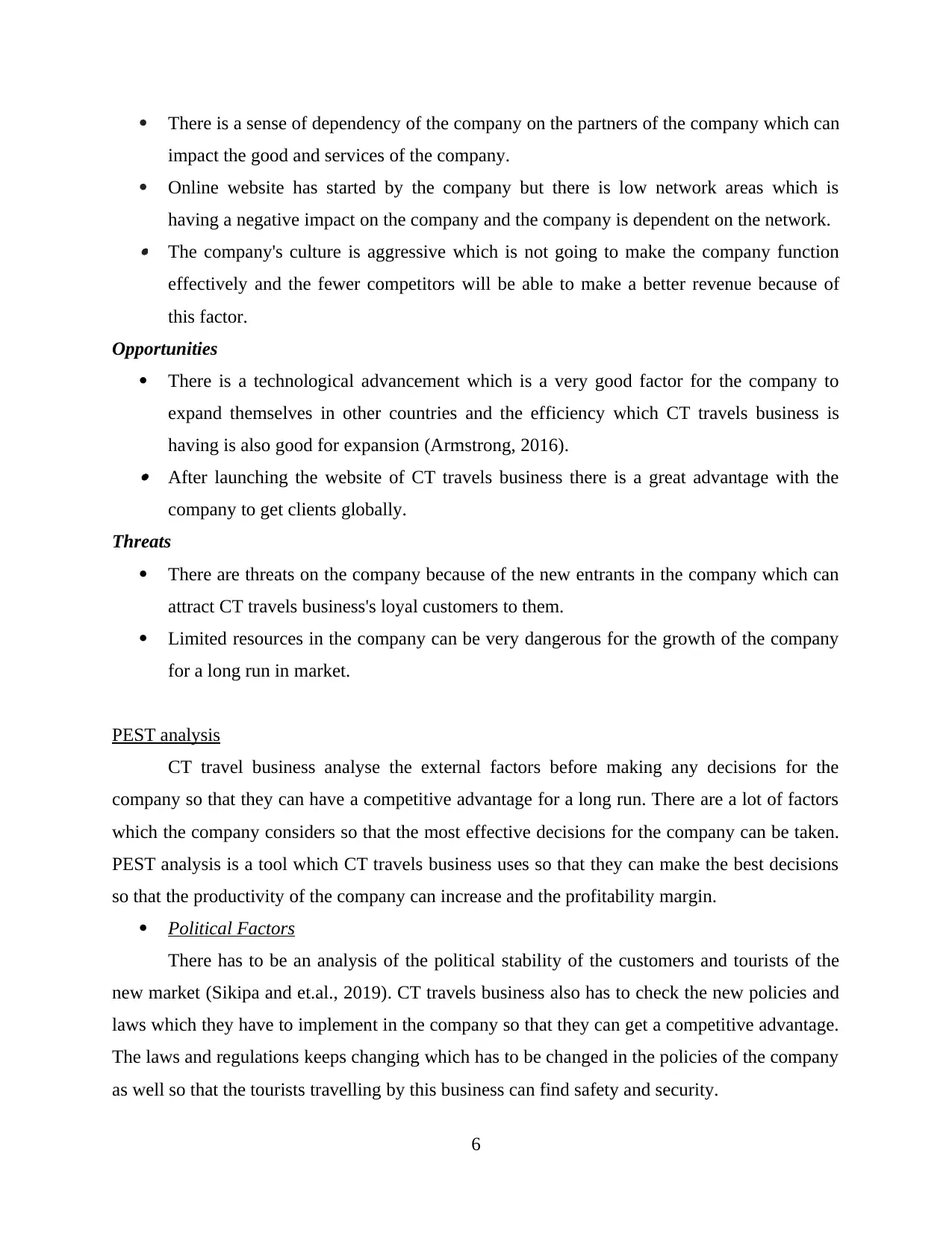
There is a sense of dependency of the company on the partners of the company which can
impact the good and services of the company.
Online website has started by the company but there is low network areas which is
having a negative impact on the company and the company is dependent on the network. The company's culture is aggressive which is not going to make the company function
effectively and the fewer competitors will be able to make a better revenue because of
this factor.
Opportunities
There is a technological advancement which is a very good factor for the company to
expand themselves in other countries and the efficiency which CT travels business is
having is also good for expansion (Armstrong, 2016). After launching the website of CT travels business there is a great advantage with the
company to get clients globally.
Threats
There are threats on the company because of the new entrants in the company which can
attract CT travels business's loyal customers to them.
Limited resources in the company can be very dangerous for the growth of the company
for a long run in market.
PEST analysis
CT travel business analyse the external factors before making any decisions for the
company so that they can have a competitive advantage for a long run. There are a lot of factors
which the company considers so that the most effective decisions for the company can be taken.
PEST analysis is a tool which CT travels business uses so that they can make the best decisions
so that the productivity of the company can increase and the profitability margin.
Political Factors
There has to be an analysis of the political stability of the customers and tourists of the
new market (Sikipa and et.al., 2019). CT travels business also has to check the new policies and
laws which they have to implement in the company so that they can get a competitive advantage.
The laws and regulations keeps changing which has to be changed in the policies of the company
as well so that the tourists travelling by this business can find safety and security.
6
impact the good and services of the company.
Online website has started by the company but there is low network areas which is
having a negative impact on the company and the company is dependent on the network. The company's culture is aggressive which is not going to make the company function
effectively and the fewer competitors will be able to make a better revenue because of
this factor.
Opportunities
There is a technological advancement which is a very good factor for the company to
expand themselves in other countries and the efficiency which CT travels business is
having is also good for expansion (Armstrong, 2016). After launching the website of CT travels business there is a great advantage with the
company to get clients globally.
Threats
There are threats on the company because of the new entrants in the company which can
attract CT travels business's loyal customers to them.
Limited resources in the company can be very dangerous for the growth of the company
for a long run in market.
PEST analysis
CT travel business analyse the external factors before making any decisions for the
company so that they can have a competitive advantage for a long run. There are a lot of factors
which the company considers so that the most effective decisions for the company can be taken.
PEST analysis is a tool which CT travels business uses so that they can make the best decisions
so that the productivity of the company can increase and the profitability margin.
Political Factors
There has to be an analysis of the political stability of the customers and tourists of the
new market (Sikipa and et.al., 2019). CT travels business also has to check the new policies and
laws which they have to implement in the company so that they can get a competitive advantage.
The laws and regulations keeps changing which has to be changed in the policies of the company
as well so that the tourists travelling by this business can find safety and security.
6
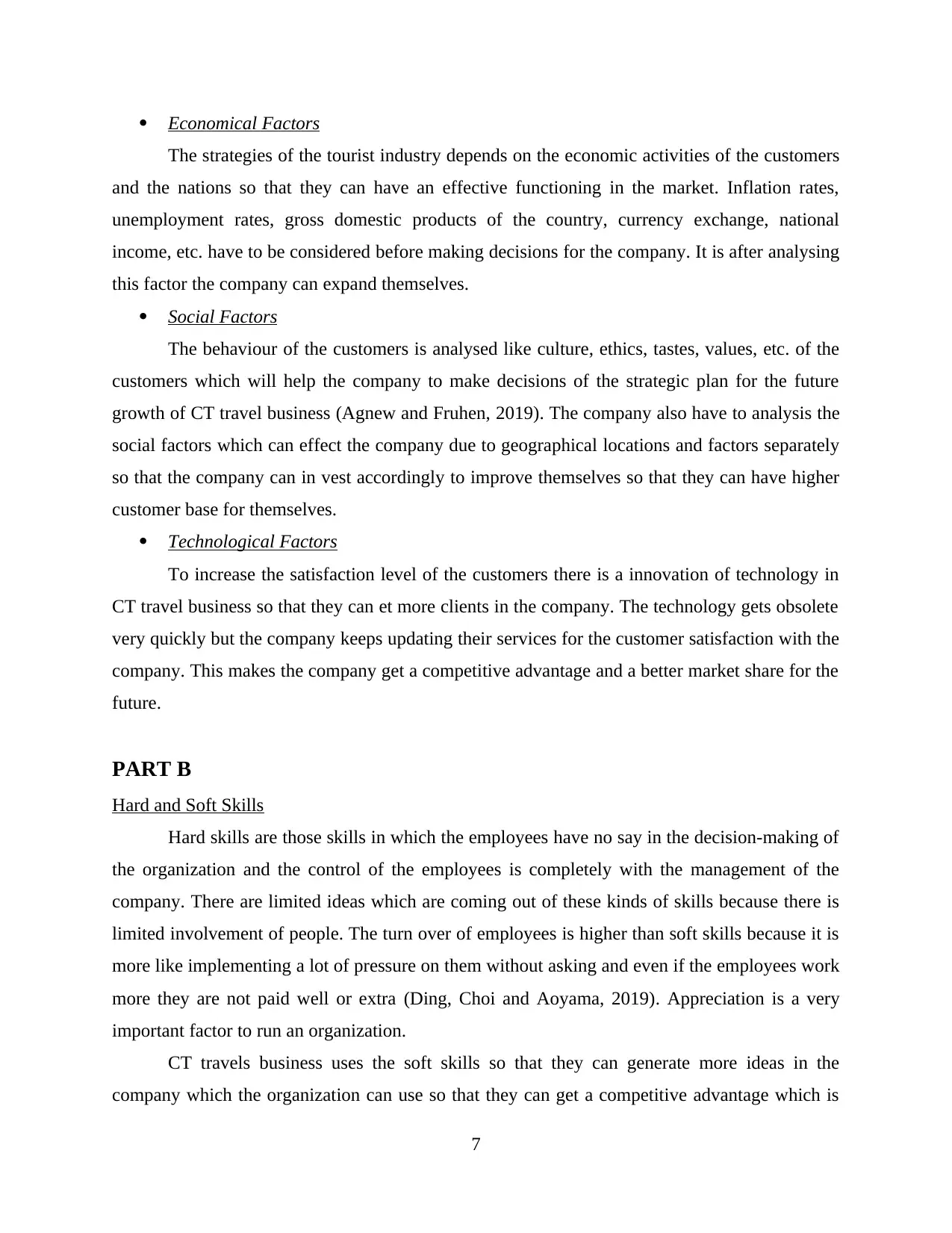
Economical Factors
The strategies of the tourist industry depends on the economic activities of the customers
and the nations so that they can have an effective functioning in the market. Inflation rates,
unemployment rates, gross domestic products of the country, currency exchange, national
income, etc. have to be considered before making decisions for the company. It is after analysing
this factor the company can expand themselves.
Social Factors
The behaviour of the customers is analysed like culture, ethics, tastes, values, etc. of the
customers which will help the company to make decisions of the strategic plan for the future
growth of CT travel business (Agnew and Fruhen, 2019). The company also have to analysis the
social factors which can effect the company due to geographical locations and factors separately
so that the company can in vest accordingly to improve themselves so that they can have higher
customer base for themselves.
Technological Factors
To increase the satisfaction level of the customers there is a innovation of technology in
CT travel business so that they can et more clients in the company. The technology gets obsolete
very quickly but the company keeps updating their services for the customer satisfaction with the
company. This makes the company get a competitive advantage and a better market share for the
future.
PART B
Hard and Soft Skills
Hard skills are those skills in which the employees have no say in the decision-making of
the organization and the control of the employees is completely with the management of the
company. There are limited ideas which are coming out of these kinds of skills because there is
limited involvement of people. The turn over of employees is higher than soft skills because it is
more like implementing a lot of pressure on them without asking and even if the employees work
more they are not paid well or extra (Ding, Choi and Aoyama, 2019). Appreciation is a very
important factor to run an organization.
CT travels business uses the soft skills so that they can generate more ideas in the
company which the organization can use so that they can get a competitive advantage which is
7
The strategies of the tourist industry depends on the economic activities of the customers
and the nations so that they can have an effective functioning in the market. Inflation rates,
unemployment rates, gross domestic products of the country, currency exchange, national
income, etc. have to be considered before making decisions for the company. It is after analysing
this factor the company can expand themselves.
Social Factors
The behaviour of the customers is analysed like culture, ethics, tastes, values, etc. of the
customers which will help the company to make decisions of the strategic plan for the future
growth of CT travel business (Agnew and Fruhen, 2019). The company also have to analysis the
social factors which can effect the company due to geographical locations and factors separately
so that the company can in vest accordingly to improve themselves so that they can have higher
customer base for themselves.
Technological Factors
To increase the satisfaction level of the customers there is a innovation of technology in
CT travel business so that they can et more clients in the company. The technology gets obsolete
very quickly but the company keeps updating their services for the customer satisfaction with the
company. This makes the company get a competitive advantage and a better market share for the
future.
PART B
Hard and Soft Skills
Hard skills are those skills in which the employees have no say in the decision-making of
the organization and the control of the employees is completely with the management of the
company. There are limited ideas which are coming out of these kinds of skills because there is
limited involvement of people. The turn over of employees is higher than soft skills because it is
more like implementing a lot of pressure on them without asking and even if the employees work
more they are not paid well or extra (Ding, Choi and Aoyama, 2019). Appreciation is a very
important factor to run an organization.
CT travels business uses the soft skills so that they can generate more ideas in the
company which the organization can use so that they can get a competitive advantage which is
7
⊘ This is a preview!⊘
Do you want full access?
Subscribe today to unlock all pages.

Trusted by 1+ million students worldwide
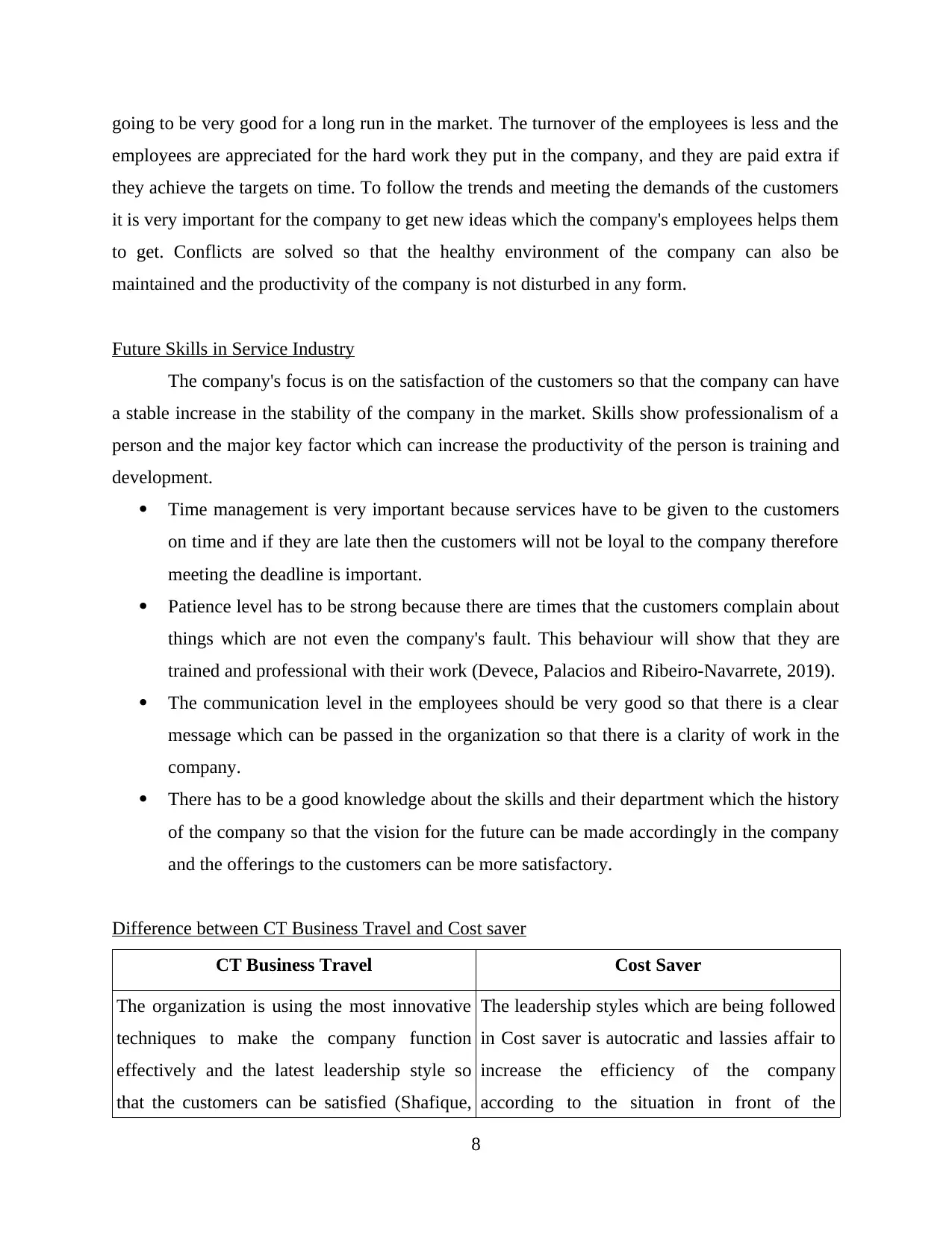
going to be very good for a long run in the market. The turnover of the employees is less and the
employees are appreciated for the hard work they put in the company, and they are paid extra if
they achieve the targets on time. To follow the trends and meeting the demands of the customers
it is very important for the company to get new ideas which the company's employees helps them
to get. Conflicts are solved so that the healthy environment of the company can also be
maintained and the productivity of the company is not disturbed in any form.
Future Skills in Service Industry
The company's focus is on the satisfaction of the customers so that the company can have
a stable increase in the stability of the company in the market. Skills show professionalism of a
person and the major key factor which can increase the productivity of the person is training and
development.
Time management is very important because services have to be given to the customers
on time and if they are late then the customers will not be loyal to the company therefore
meeting the deadline is important.
Patience level has to be strong because there are times that the customers complain about
things which are not even the company's fault. This behaviour will show that they are
trained and professional with their work (Devece, Palacios and Ribeiro-Navarrete, 2019).
The communication level in the employees should be very good so that there is a clear
message which can be passed in the organization so that there is a clarity of work in the
company.
There has to be a good knowledge about the skills and their department which the history
of the company so that the vision for the future can be made accordingly in the company
and the offerings to the customers can be more satisfactory.
Difference between CT Business Travel and Cost saver
CT Business Travel Cost Saver
The organization is using the most innovative
techniques to make the company function
effectively and the latest leadership style so
that the customers can be satisfied (Shafique,
The leadership styles which are being followed
in Cost saver is autocratic and lassies affair to
increase the efficiency of the company
according to the situation in front of the
8
employees are appreciated for the hard work they put in the company, and they are paid extra if
they achieve the targets on time. To follow the trends and meeting the demands of the customers
it is very important for the company to get new ideas which the company's employees helps them
to get. Conflicts are solved so that the healthy environment of the company can also be
maintained and the productivity of the company is not disturbed in any form.
Future Skills in Service Industry
The company's focus is on the satisfaction of the customers so that the company can have
a stable increase in the stability of the company in the market. Skills show professionalism of a
person and the major key factor which can increase the productivity of the person is training and
development.
Time management is very important because services have to be given to the customers
on time and if they are late then the customers will not be loyal to the company therefore
meeting the deadline is important.
Patience level has to be strong because there are times that the customers complain about
things which are not even the company's fault. This behaviour will show that they are
trained and professional with their work (Devece, Palacios and Ribeiro-Navarrete, 2019).
The communication level in the employees should be very good so that there is a clear
message which can be passed in the organization so that there is a clarity of work in the
company.
There has to be a good knowledge about the skills and their department which the history
of the company so that the vision for the future can be made accordingly in the company
and the offerings to the customers can be more satisfactory.
Difference between CT Business Travel and Cost saver
CT Business Travel Cost Saver
The organization is using the most innovative
techniques to make the company function
effectively and the latest leadership style so
that the customers can be satisfied (Shafique,
The leadership styles which are being followed
in Cost saver is autocratic and lassies affair to
increase the efficiency of the company
according to the situation in front of the
8
Paraphrase This Document
Need a fresh take? Get an instant paraphrase of this document with our AI Paraphraser
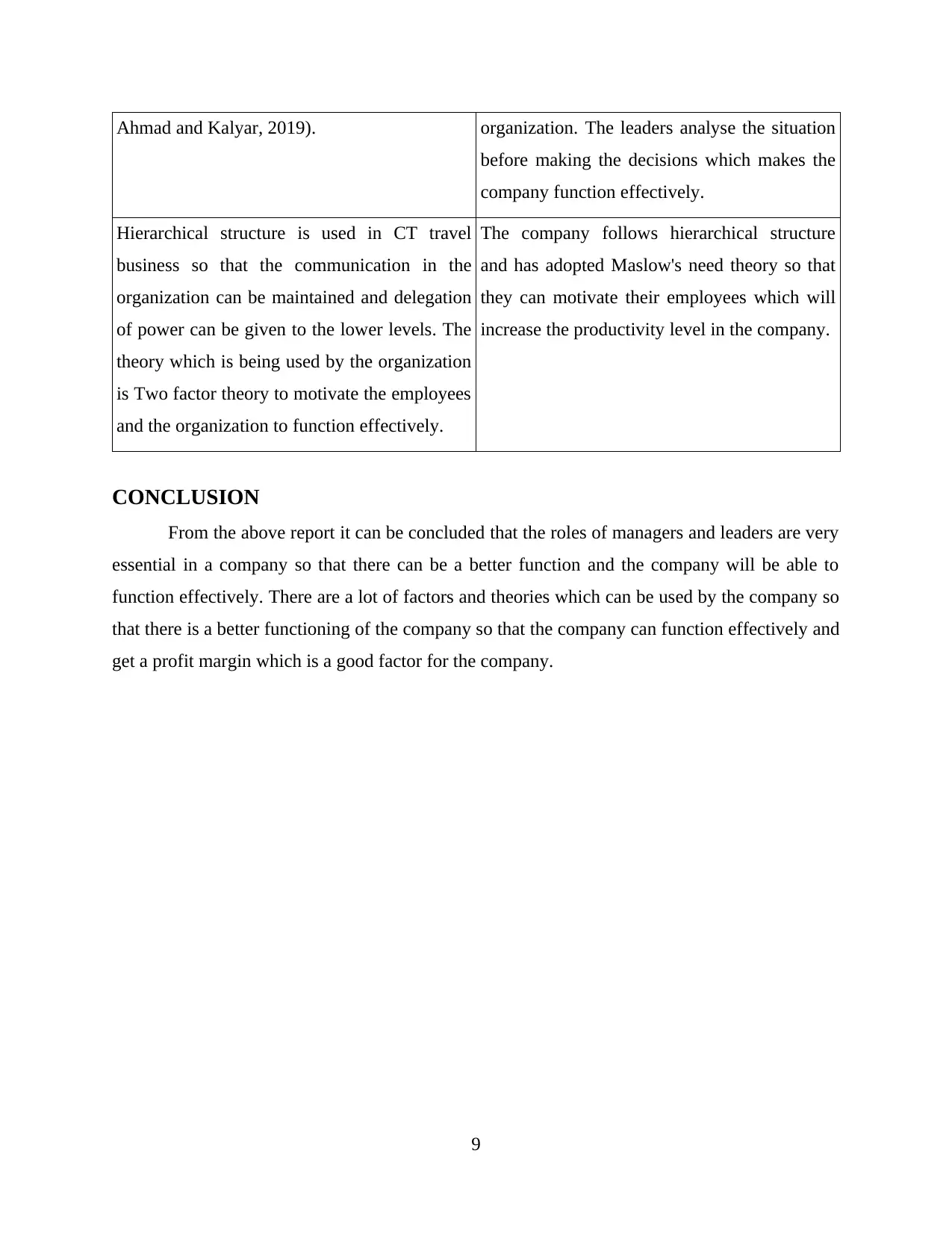
Ahmad and Kalyar, 2019). organization. The leaders analyse the situation
before making the decisions which makes the
company function effectively.
Hierarchical structure is used in CT travel
business so that the communication in the
organization can be maintained and delegation
of power can be given to the lower levels. The
theory which is being used by the organization
is Two factor theory to motivate the employees
and the organization to function effectively.
The company follows hierarchical structure
and has adopted Maslow's need theory so that
they can motivate their employees which will
increase the productivity level in the company.
CONCLUSION
From the above report it can be concluded that the roles of managers and leaders are very
essential in a company so that there can be a better function and the company will be able to
function effectively. There are a lot of factors and theories which can be used by the company so
that there is a better functioning of the company so that the company can function effectively and
get a profit margin which is a good factor for the company.
9
before making the decisions which makes the
company function effectively.
Hierarchical structure is used in CT travel
business so that the communication in the
organization can be maintained and delegation
of power can be given to the lower levels. The
theory which is being used by the organization
is Two factor theory to motivate the employees
and the organization to function effectively.
The company follows hierarchical structure
and has adopted Maslow's need theory so that
they can motivate their employees which will
increase the productivity level in the company.
CONCLUSION
From the above report it can be concluded that the roles of managers and leaders are very
essential in a company so that there can be a better function and the company will be able to
function effectively. There are a lot of factors and theories which can be used by the company so
that there is a better functioning of the company so that the company can function effectively and
get a profit margin which is a good factor for the company.
9
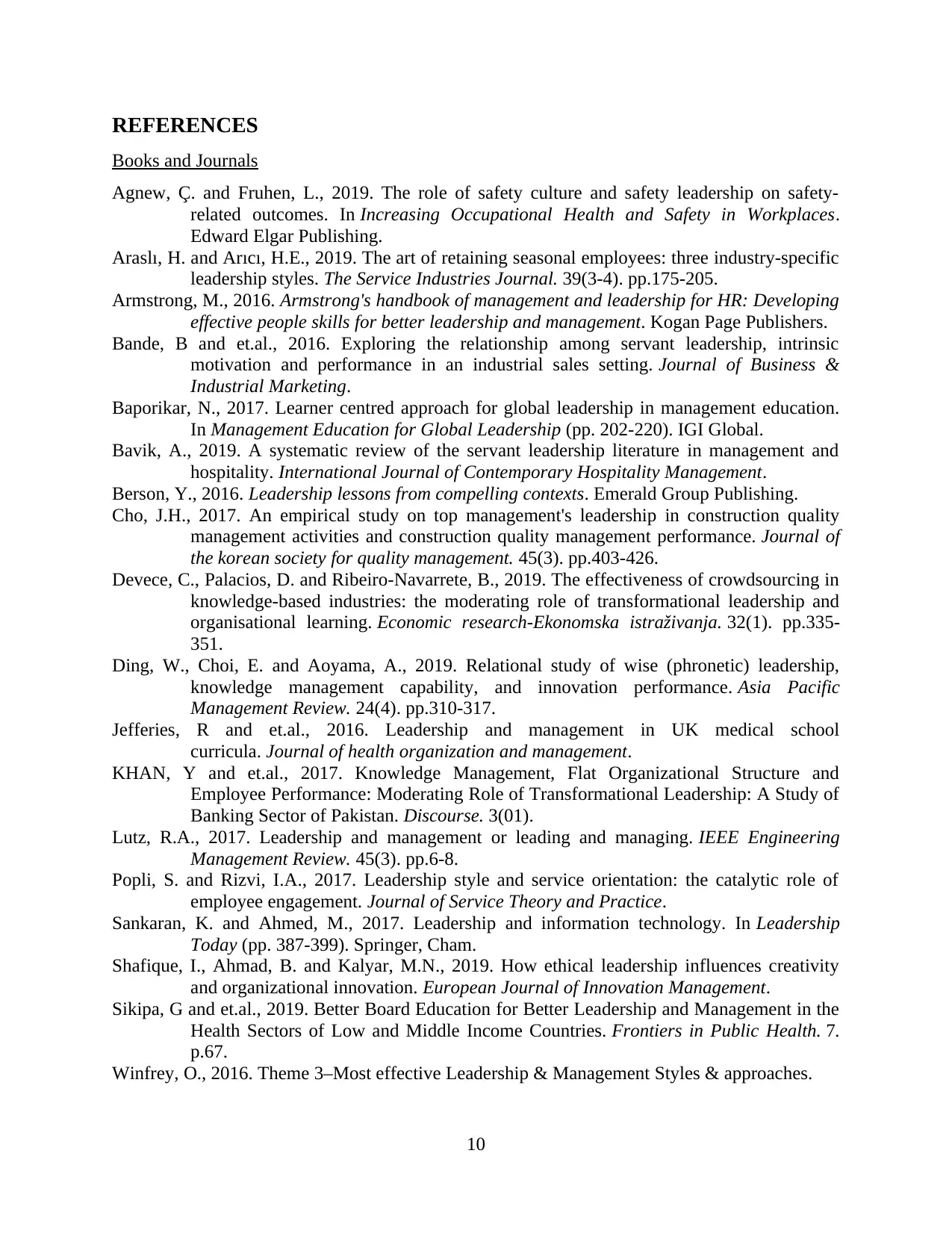
REFERENCES
Books and Journals
Agnew, Ç. and Fruhen, L., 2019. The role of safety culture and safety leadership on safety-
related outcomes. In Increasing Occupational Health and Safety in Workplaces.
Edward Elgar Publishing.
Araslı, H. and Arıcı, H.E., 2019. The art of retaining seasonal employees: three industry-specific
leadership styles. The Service Industries Journal. 39(3-4). pp.175-205.
Armstrong, M., 2016. Armstrong's handbook of management and leadership for HR: Developing
effective people skills for better leadership and management. Kogan Page Publishers.
Bande, B and et.al., 2016. Exploring the relationship among servant leadership, intrinsic
motivation and performance in an industrial sales setting. Journal of Business &
Industrial Marketing.
Baporikar, N., 2017. Learner centred approach for global leadership in management education.
In Management Education for Global Leadership (pp. 202-220). IGI Global.
Bavik, A., 2019. A systematic review of the servant leadership literature in management and
hospitality. International Journal of Contemporary Hospitality Management.
Berson, Y., 2016. Leadership lessons from compelling contexts. Emerald Group Publishing.
Cho, J.H., 2017. An empirical study on top management's leadership in construction quality
management activities and construction quality management performance. Journal of
the korean society for quality management. 45(3). pp.403-426.
Devece, C., Palacios, D. and Ribeiro-Navarrete, B., 2019. The effectiveness of crowdsourcing in
knowledge-based industries: the moderating role of transformational leadership and
organisational learning. Economic research-Ekonomska istraživanja. 32(1). pp.335-
351.
Ding, W., Choi, E. and Aoyama, A., 2019. Relational study of wise (phronetic) leadership,
knowledge management capability, and innovation performance. Asia Pacific
Management Review. 24(4). pp.310-317.
Jefferies, R and et.al., 2016. Leadership and management in UK medical school
curricula. Journal of health organization and management.
KHAN, Y and et.al., 2017. Knowledge Management, Flat Organizational Structure and
Employee Performance: Moderating Role of Transformational Leadership: A Study of
Banking Sector of Pakistan. Discourse. 3(01).
Lutz, R.A., 2017. Leadership and management or leading and managing. IEEE Engineering
Management Review. 45(3). pp.6-8.
Popli, S. and Rizvi, I.A., 2017. Leadership style and service orientation: the catalytic role of
employee engagement. Journal of Service Theory and Practice.
Sankaran, K. and Ahmed, M., 2017. Leadership and information technology. In Leadership
Today (pp. 387-399). Springer, Cham.
Shafique, I., Ahmad, B. and Kalyar, M.N., 2019. How ethical leadership influences creativity
and organizational innovation. European Journal of Innovation Management.
Sikipa, G and et.al., 2019. Better Board Education for Better Leadership and Management in the
Health Sectors of Low and Middle Income Countries. Frontiers in Public Health. 7.
p.67.
Winfrey, O., 2016. Theme 3–Most effective Leadership & Management Styles & approaches.
10
Books and Journals
Agnew, Ç. and Fruhen, L., 2019. The role of safety culture and safety leadership on safety-
related outcomes. In Increasing Occupational Health and Safety in Workplaces.
Edward Elgar Publishing.
Araslı, H. and Arıcı, H.E., 2019. The art of retaining seasonal employees: three industry-specific
leadership styles. The Service Industries Journal. 39(3-4). pp.175-205.
Armstrong, M., 2016. Armstrong's handbook of management and leadership for HR: Developing
effective people skills for better leadership and management. Kogan Page Publishers.
Bande, B and et.al., 2016. Exploring the relationship among servant leadership, intrinsic
motivation and performance in an industrial sales setting. Journal of Business &
Industrial Marketing.
Baporikar, N., 2017. Learner centred approach for global leadership in management education.
In Management Education for Global Leadership (pp. 202-220). IGI Global.
Bavik, A., 2019. A systematic review of the servant leadership literature in management and
hospitality. International Journal of Contemporary Hospitality Management.
Berson, Y., 2016. Leadership lessons from compelling contexts. Emerald Group Publishing.
Cho, J.H., 2017. An empirical study on top management's leadership in construction quality
management activities and construction quality management performance. Journal of
the korean society for quality management. 45(3). pp.403-426.
Devece, C., Palacios, D. and Ribeiro-Navarrete, B., 2019. The effectiveness of crowdsourcing in
knowledge-based industries: the moderating role of transformational leadership and
organisational learning. Economic research-Ekonomska istraživanja. 32(1). pp.335-
351.
Ding, W., Choi, E. and Aoyama, A., 2019. Relational study of wise (phronetic) leadership,
knowledge management capability, and innovation performance. Asia Pacific
Management Review. 24(4). pp.310-317.
Jefferies, R and et.al., 2016. Leadership and management in UK medical school
curricula. Journal of health organization and management.
KHAN, Y and et.al., 2017. Knowledge Management, Flat Organizational Structure and
Employee Performance: Moderating Role of Transformational Leadership: A Study of
Banking Sector of Pakistan. Discourse. 3(01).
Lutz, R.A., 2017. Leadership and management or leading and managing. IEEE Engineering
Management Review. 45(3). pp.6-8.
Popli, S. and Rizvi, I.A., 2017. Leadership style and service orientation: the catalytic role of
employee engagement. Journal of Service Theory and Practice.
Sankaran, K. and Ahmed, M., 2017. Leadership and information technology. In Leadership
Today (pp. 387-399). Springer, Cham.
Shafique, I., Ahmad, B. and Kalyar, M.N., 2019. How ethical leadership influences creativity
and organizational innovation. European Journal of Innovation Management.
Sikipa, G and et.al., 2019. Better Board Education for Better Leadership and Management in the
Health Sectors of Low and Middle Income Countries. Frontiers in Public Health. 7.
p.67.
Winfrey, O., 2016. Theme 3–Most effective Leadership & Management Styles & approaches.
10
⊘ This is a preview!⊘
Do you want full access?
Subscribe today to unlock all pages.

Trusted by 1+ million students worldwide
1 out of 12
Related Documents
Your All-in-One AI-Powered Toolkit for Academic Success.
+13062052269
info@desklib.com
Available 24*7 on WhatsApp / Email
![[object Object]](/_next/static/media/star-bottom.7253800d.svg)
Unlock your academic potential
Copyright © 2020–2025 A2Z Services. All Rights Reserved. Developed and managed by ZUCOL.





